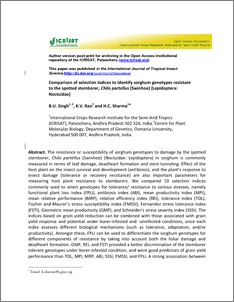Comparison of selection indices to identify sorghum genotypes resistant to the spotted stemborer, Chilo partellus (Swinhoe) (Lepidoptera: Noctuidae)
Abstract
The resistance or susceptibility of sorghum genotypes to damage by the spotted stemborer Chilo partellus (Swinhoe) is commonly measured in terms of leaf damage, deadheart formation and stem tunnelling. Effect of the host plant on the insect survival and development (antibiosis) and the response of the plant to insect damage (tolerance or recovery resistance) are also important parameters for measuring host plant resistance to stemborers. We compared ten selection indices commonly used to select genotypes for tolerance/resistance to various stresses, namely functional plant loss index (FPLI), antibiosis index (ABI), mean productivity index (MPI), mean relative performance (MRP), relative efficiency index (REI), tolerance index (TOL), Fischer's and Maurer's stress susceptibility index (FMSSI), Fernandez stress tolerance index (FSTI), geometric mean productivity (GMP) and Schneider's stress severity index (SSSI). The results suggest that the indices based on grain yield reduction can be combined with those associated with grain yield response and potential under borer-infested and uninfested conditions, since each index assesses different biological mechanisms (such as tolerance, adaptation and/or productivity). Among these, FPLI can be used to differentiate the sorghum genotypes for different components of resistance by taking into account both foliar damage and deadheart formation. GMP, REI and FSTI provided a better discrimination of the stemborer-tolerant genotypes under borer-infested conditions, and were better predictors of grain yield performance than TOL, MPI, MRP, ABI, SSSI, FMSSI and FPLI. A strong association between GMP and REI indicated that both these indices could be used to select for low grain yield loss and high productivity. However, the selection of genotypes with high grain yield potential and adaptation to borer infestation may be achieved by combining selection indices related to the mean grain yield performance under borer-infested and uninfested conditions (GMP and REI), and low levels of grain yield loss under borer infestation

